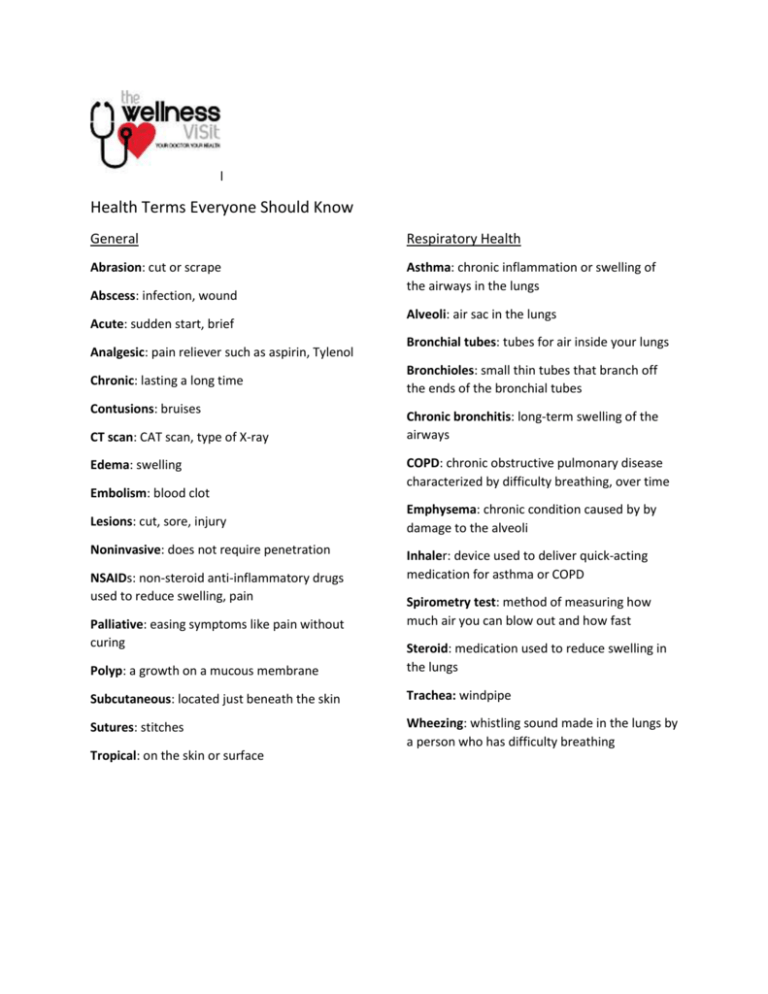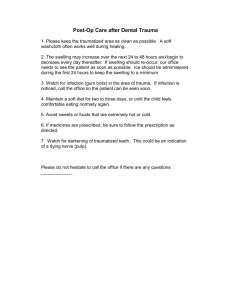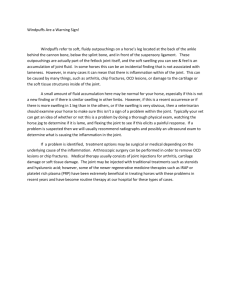Health Terms Everyone Should Know
advertisement

l Health Terms Everyone Should Know General Respiratory Health Abrasion: cut or scrape Asthma: chronic inflammation or swelling of the airways in the lungs Abscess: infection, wound Acute: sudden start, brief Analgesic: pain reliever such as aspirin, Tylenol Chronic: lasting a long time Contusions: bruises CT scan: CAT scan, type of X-ray Edema: swelling Embolism: blood clot Lesions: cut, sore, injury Noninvasive: does not require penetration NSAIDs: non-steroid anti-inflammatory drugs used to reduce swelling, pain Palliative: easing symptoms like pain without curing Alveoli: air sac in the lungs Bronchial tubes: tubes for air inside your lungs Bronchioles: small thin tubes that branch off the ends of the bronchial tubes Chronic bronchitis: long-term swelling of the airways COPD: chronic obstructive pulmonary disease characterized by difficulty breathing, over time Emphysema: chronic condition caused by by damage to the alveoli Inhaler: device used to deliver quick-acting medication for asthma or COPD Spirometry test: method of measuring how much air you can blow out and how fast Polyp: a growth on a mucous membrane Steroid: medication used to reduce swelling in the lungs Subcutaneous: located just beneath the skin Trachea: windpipe Sutures: stitches Wheezing: whistling sound made in the lungs by a person who has difficulty breathing Tropical: on the skin or surface Joint Health Diabetes Arthroplasty: rebuilding of joints, or total joint replacement Blood glucose: type of sugar in your blood that is a source of fuel Arthroscopy: minimally invasive knee surgery using a lighted scope and narrow instruments inserted through small incisions in the skin Diabetic retinopathy: damage caused to the eyes by poorly controlled blood sugar levels Bursitis: pain resulting from swollen fluids-filled sacs (bursa) around bones, muscles and tendons Cartilage: smooth covering of the ends of bones Corticosteroids: drug that suppresses inflammation Glucosamine: substance produced by the body to grow, repair and maintain cartilage Glucagon: hormone produced in the pancreas, also a medicine used to raise very low blood sugar Hyperglycemia; occurs when the body doesn’t produce enough insulin or use it effectively; elevated blood sugar levels Hypoglycemia: low blood sugar (or blood glucose) Islets: insulin producing cells in the pancreas Gout: painful swelling in a joint caused by the buildup of uric acid Insulin: blood sugar essential for producing glucose and using it for energy Ligament: strong band of tissue that holds joints together Ketones: substances produced when fat cells break down in the blood Meniscus: shock absorbing, stabilizing tissue between the bones of the knee Neuropathy: tingling or numbness, often in the extremities, common diabetes side effect Nodule: swollen or raised bump Prediabetes: when blood sugar levels are elevated but not high enough to be diagnosed as diabetes Osteoarthritis: joint disease that causes the breakdown of cartilage over time Range of motion: the area through which joints are designated to move Rheumatologist: doctor with specialized training in treating joints, bones and the immune system Rheumatoid arthritis: an inflammatory for of arthritis Tendinitis: inflammation of the cord-like structure that connects muscles to bones Heart Health Aneurysm: abnormal ballooning of artery Angina: chest pain Atherosclerosis: disease caused by a buildup of plaque in your arteries Arteriosclerosis: hardening of the arteries Arrhythmia: problem with the rhythm or speed of the heart Atrial fibrillation: most common arrhythmia, caused by electrical problem in the heart Cardiac arrest: when an arrhythmia causes the heart to suddenly stop beating Cardiovascular: related to the heart and blood vessels Echocardiogram: test that uses sound waves to create a moving picture of the heart Heart failure: when the heart cannot pump enough blood to the rest of the body Hypertension: high blood pressure Ischemia: when the heart muscle is starved for oxygen and nutrients; can lead to a heart attack Lipids: fats in the blood Myocardial infraction: when blood flow to part of the heart is cut off long enough to cause brain damage (aka heart attack) Pacemaker: implantable device that delivers electrical pulses so the heart will beat in a more normal rhythm Palpitations: sensation that the heart is racing or pounding Vasodilator: medication that opens blood vessels






